
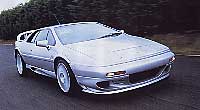
NO CHANGE OF HEART
Lotus's classic Esprit may have had a facelift, but underneath it's still the same as it always was — a blindingly quick, adrenalin-pumping supercar
As gestation periods go, the four year it took Colin Chapman to finally get an Esprit on the road after its first public showing in 1972 was a touch on the lengthy side, to say the least. Didn't bode well, either. Historically, British sports cars that are reluctant to take on a self-propelling, three-dimensional and, most crucial of all, a purchasable form, are not destined for great things: I give you the Panther Solo and Strathcarron SC-5A as masters of the trade.
Odd, then, that the funny little plastic coupe from Norfolk whose shape was cunningly inspired by a wedge of gouda cheese — the car that took 007 swimming and skiing — has been on sale continuously since 1976. Good news, too, because it means there has long been another supercar out there to keep the Aston company — for those patriotic enough to care about such things — wrapped in a Union Jack and generally adored. The Esprit is ours.
Time and circumstances have been kind to Esprit. It exists in the world where a decade is considered a short production life; a place where the supreme expression of this type of vehicle, the Porsche 911, has had the same basic shape and mechanical layout for 37 years. Next time someone points out just how grey the Esprit is getting, remind them that the Porsche had 12 candles on its birthday cake the year the Lotus was born. Nevertheless, age is a measure of experience, and the Esprit has done time, and plenty of it.
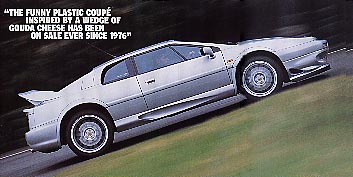
And it's likely to be with us for a while yet, because Lotus has decided to carry on building the thing. That's not quite the brave upstanding decision it sounds, either. To be honest, the car sells in tiny volumes in this country, but US sales are healthier. And if you've got the tooling, know each car makes money and want a supercar on the company notepaper for brand reasons, it makes perfect sense.
There are less tangible reasons, too. Chapman wouldn't recognize his cosy little Hethel facility in it Y2K plus one specification. It's a big place now, churning out Elises and Vauxhall VX220s. But no one at the company has forgotten the initials on that yellow and green badge.
In line with Chapman's engineering and work ethic, the sports cars are still light, bodywork is still plastic and Friday remains a half day. But the one remaining, wholly physical link with Lotus circa 2001 and the guv'nor himself is the Esprit. That alone should be a reason for knocking them out at a glacial rate.
Press literature concerning the alterations to the new Esprit isn't extensive. It doesn't have to be. Five words suffice: new rear lights, new wheels. As overhauls go, it won't be remembered alongside the great automotive transformations, but getting stuck in a four-hour snarl-up on the A11 en route to Hethel gives us time to remind ourselves why the Esprit's dynamics have always been held in high regard. For the record, by the way, those new light clusters look pleasantly reminiscent of Ferrari, and the latest OZ wheels are pretty easy on the eye as well.
But let's give credit where it's really due. Take a shufty through the spec sheet and you quickly realise that only the most twisted power junkies would want to meddle with the Esprit's gizzards. This supposedly geriatric two-seater still has a tidy 358bhp at 6500rpm and 295lb ft of torque at 4250rpm: enough welt to deal with just about anything on the planet and, given the twin-turbo-induced flat-torque curve, available all the time.
The rest is as before: steel backbone chassis with frames for the front and rear double-wishbone suspension. Seems rather a quaint layout at a time when the Elise gets full aluminum and industrial Pritt Stick treatment.
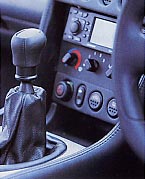
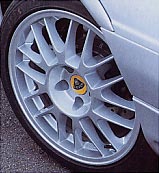
But chassis configuration is currently the last thing on my mind, because today's first discipline is some fast lap work. And from where I'm sitting it feels like the track's covered in oil — not the ideal surface on which to reacquaint oneself with a 350bhp mid-engined supercar. This is my first steer in an Esprit around Lotus's own circuit and despite knowing the place reasonably well, wet or dry, I'm struggling.

Struggling to get the thing out of second gear bends without spinning the inside rear-wheel and slapping the rev-limiter; struggling with how little grip the Dunlops seem to offer in these conditions. Wondering, between you and me, why on earth Lotus wants to keep on building the thing. Two laps down and it feels old enough for a day-in-the-life-of billing on Walking with Beasts.
Peeling off, come back in, smile at the Lotus boys when they ask me what I think and get a cup of char down my neck. Fast. Because my mind's a whirl of negativity: the car feels ancient the moment you open the door. Comfy, supportive chair, mad flat-pane of glass for a windshield and a splattering of switchgear that Peugeot deemed decrepit enough to ditch with the 306. The gearbox is close to shambolic, and the throttle pedal's set so high Geri Halliwell could only just about articulate the old heel'n'toe with her rudest pair of platforms. Yikes.
Get it rolling; still nothing like enough noise from the flat-plane V8, but is certainly goes hard enough. God, there's that ruddy gearchange again, but on thing's starting to shine through: the steering. Assisted racks don't come much better than this for the simple reason that it doesn't fell hydraulically aided in any way. It's fast, fingertip accurate, and a real pleasure. Need to try it again.
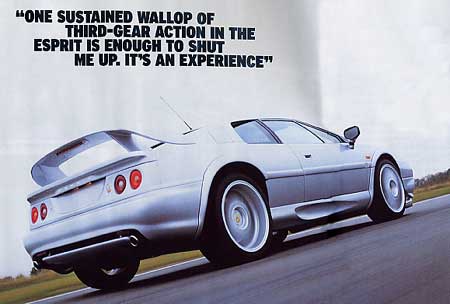
Nose out slowly, one to three: short shift to fourth. Move the car around on the straight a bit just to confirm how reassuring the rack is. Building speed into the lap now, later on the gas coming out of bends, allowing the tyres a smidge more time to cope with the torque reaction and the old boy's starting to work. Three more laps like this then — taking advantage of the torque rather than cursing it as an incendiary demolisher of unsuspecting Dunlops. Still, the Esprit deserves a limited-slip diff and not the open one that hastens such single-tyre executions.
Two things learnt, then: first, how unaccustomed we've become to a rear-drive chassis with massive power but without traction control. In the dry this thing'll easily liquorice your asphalt; just how I though it'd take the full monty in the damp I'll never know. The second is more pertinent; profuse thanks to my commonsense, not to say courteous, instincts for keeping me quiet when the Lotus lads asked me what I thought. Could have gone off a little too half-cocked at this point. As I've already implied, this car couldn't have survived for so long on mindless muscle alone.
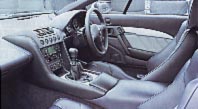
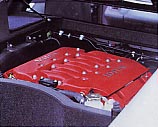
More tea, then. Beyond the steering, it's the Esprit's composure that impresses most. In Lotus speak it 'breathes' with the road surface, doing its very best to deal with surface imperfections rather than just skip over them. Supple's the word.
As is quick. And massively. I've been as guilty as anyone of late of telling the world that the SubaBishi rally-nutter revolution has all but killed the supercar. Well, one sustained wallop of third-gear action in the Esprit is enough to shut me up. No, you can't use it often and, no it's not nearly as fast cross-country, but it sure has the car-nutter gland secreting a huge dose of adrenalin.
However, the Esprit is the purveyor of a much blacker magic than anything its chassis can offer. It's an experience. It may not have anything like the emotional magnetism of a Ferrari, but it deserves to be categorized alongside such cars for what it offers. The Ministry of Sound would package the Esprit as 'Old School', celebrate its oddities and its age. From my seat it's not that easy — a 911 is similar money, just as fast and far better dynamically. And it's an experience, too.
But even the Porsche doesn't pass the ultimate supercar test as well as the Lotus. Take one Esprit, one suburban road, preferably near a school, and cruise at 15mph. Add 10 kids and watch them go berserk. It's a car capable of making grown men fall over just pointing at it. And that's just cool.
Keeping the spirit alive
Despite
the arrival of the Elise, the Esprit still has a certain something
which means it should be around for a while yet
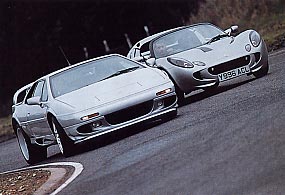
Elise
may be lighter and more agile, but Esprit can still raise a smile
THEY KNOW IT'S A RELIC, But the Lotus Esprit genuinely defines the difference between a product that deserves to live in small volumes, and one that really should crawl under a rock and die — because despite its age, the old lad is a surprisingly appealing car. Lotus is under no illusion that the Esprit has what it takes to claw market share from Porsche, but because its dynamics in no way detract from the brand, it's happy to keep building the cars.
And then you do something foolish, like ask Lotus to justify why they'd bother to do such a thing. And, as is always the case with Lotus (and hopefully always will be), they don't just wheel a PR face out to spout market garbage. They provide one smiley engineer and a bucket full of data.
Data that illustrates how different the car is from any other current Lotus product. And that reminds you just how fast the thing is. Standing start acceleration has long been an Esprit A-grade subject, and this latest version is no different. Not much can live with 0-60mph in 4.8sec and 0-100mph in 10.5sec. And it's beyond three figures that it'll prove most damaging to an Evo VII's ego.
And so to their beloved circuit, a place that illustrates the positive and negative aspects of real supercar performance. Considering Hethel has a straight long enough for the Esprit to hit 144mph, it's amazing that the Elise is only 2.2sec slower over a lap, since it can manage only 122mph at the same point. Much of the difference is down to the Elise's lighter kerb weight and greater agility, but modern chassis design means Lotus boys have allowed the Elise to use its tyres far more efficiently.
But then they put the paperwork away, look at the Esprit parked among hundreds of Elises, and smile. Start talking like car nuts; gesturing with armfuls of opposite lock, telling me it's a shot in the arm, almost insanely fast and a real fix when you're in the mood. That's the thing about the Esprit: it's a car that's easily supported by objective data, even if it hasn't benefited from the chassis revolution that's happened at Lotus post-Elise. We won't see a new product for a long time; maybe never. Best enjoy Norfolk's only supercar while it's around.
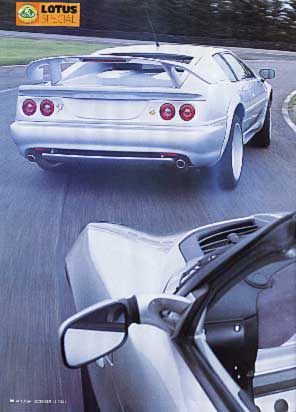
|
|